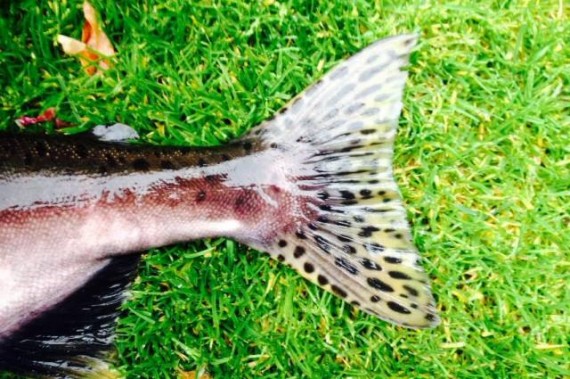A Pacific Pink Salmon was caught in the mouth of the Spey at the beginning of the week and another has since been caught in the Spey, which was returned before the identity had been confirmed from a photograph. The Speymouth fish was retained and has been frozen pending examination.
The following advice note has been issued and The Spey Fishery Board recommends that if any angler does catch one of these fish it should be killed and retained for examination.
Pacific Pink Salmon
Advice Note: July 2017
Background
In recent weeks, anglers in Scotland (particularly on the Rivers Ness, Dee and Helmsdale, but also here on the Spey) have reported several captures of fresh run non-native Pink Salmon (Oncorhynchus gorbuscha). Some captures have also been reported in some salmon net fisheries in Scotland and both rod and net fisheries in England and Ireland. These fish are not native to Scotland and are likely to have ‘strayed’ from some of the rivers in northern Norway or Russia. These fish were originally introduced to some Russian rivers in the 1960s, have slowly spread westwards and have now colonised some northern Norwegian rivers. These fish spawn at a different time from Atlantic salmon, have a 2-year lifecycle and generally spawn in summer (and often in main river channels, in the lower reaches of rivers, and sometimes in upstream tributaries). Due to their 2 - year lifecycle, the progeny will be derived from distinct ‘odd’ or ‘even’ years, with the Russian/Norwegian fish being odd-year stocks. It is therefore possible, and likely, that they will occur again in 2019. Whilst it is theoretically possible that these non-native species could establish themselves in Scottish rivers, the higher water temperatures make this unlikely. Whilst the risks are not known, in terms of their interaction with Atlantic salmon and other native Scottish fish, they are unlikely to have a positive impact.
Identification
Pacific pink salmon, when fresh from the sea, are steel blue to blue-green on their backs, silver on the flanks and white on their bellies. There are large black spots on the backs, upper flanks, adipose fins and tail – some of the spots on the tail can be as large as the fish’s eyes. They are very uniform in size, reaching only 40 to 60cms in length.
‘Fresh run’ pink salmon
Note shape of tail, spots on tail and dark mouth. Images courtesy of Peter Quail, Helmsdale DSFB
Breeding males are immediately identifiable because of their humps and they will almost certainly be running milt at this time of year. Their black tongues and heavily spotted tails are also very obvious. Females will show heavily spotted tails and be pinkish-brown on the flanks.
Male Pink salmon in breeding colouration – note the shape of body and heavily spotted tail
Image courtesy of Nigel Fell
What should you do if you capture a Pacific salmon?
As above, Pacific pink salmon are usually clearly identifiable from their Atlantic counterparts – particularly when mature and in spawning condition. If you are confident that you have captured a pacific pink salmon, it should be humanely despatched and retained. It would be helpful if captures could be reported to the Spey Fishery Board using the contact details for further information below. If it is practical to do so, please pass the fish to the biologists at the Spey Fishery Board for further inspection and analysis.
For further information please contact:
Brian Shaw, Biologist, Spey Fishery Board
Tel: 01340-810841 or 07502-302723
E-mail: [email protected]
Roger Knight, Director, Spey Fishery Board
Tel: 01340-810841 or 07919-284482
E-mail: [email protected]
Sally Gross, Administrator, Spey Fishery Board
Tel: 01340-810841
E-mail: [email protected]
The post Look out for Pacific Pink Salmon appeared first on Spey Fishery Board.
Spey Fishery Board



